Tashi Laptsa: Do It Yourself
Those of you who have been following this column may wonder about the logic of not including mountaineering as a form of partourism (participatory tourism). After all, if the goal is "to interact with our hosts in ways that involve us as more than voyeurs [and to establish] the basis for long-term relationships and return visits," what better agenda than hiking and climbing among remote communities, employing native specialists to organize and field expeditions, and returning year after year to trek new routes and bag new peaks in the most spectacular country on Earth?
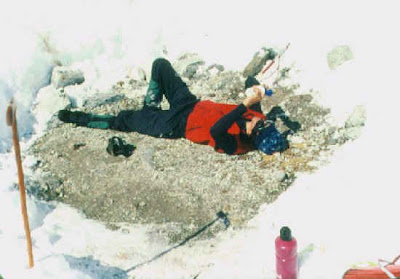
My feeling is that mountaineering can be a rather solipsistic, even onanistic, pastime. Anyone who read Jon Krakauer's Into Thin Air (about the 1996 disaster on Mt. Everest) is unlikely to forget social climber Sandy Pittman, "doing" Everest with her cappuccino maker and laptop, short-leashed to the summit by Lopsang Sherpa. There are, of course, less patrician forms of mountaineering.
More to the point, my list of partour-ops in last month's column was not supposed to be a guide to acceptable tourist behavior. Personally, I don't think we need to be "engaged" at every step of the way. In fact, I favor independent backpacking precisely because I don't want to have to deal with a porter or guide monitoring my pit-stops, trying to engage me in small talk, leading me out of the way to visit his family, and judging the value of the whole experience based on the size of a tip. Not that those are necessarily bad things. I just prefer to carry my own pack, set my own pace, and struggle in silence.
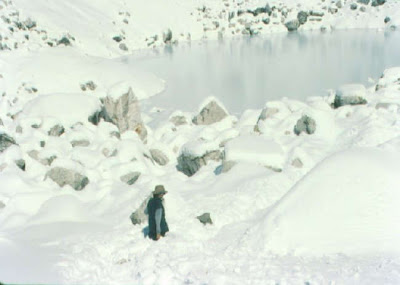
Even so, there are times when you need help. If you're going to do a multi-stage climb, or trek for more than a few days in a remote area with no food or accommodations, or spend time in an unfamiliar and dangerous area, you'll probably want to hire porters -- and perhaps engage a guide, or even contract with an outfitter to put together the entire expedition. Unless you're Bear Grylls, of course. Just keep in mind that there's a full crew behind the camera watching him chow down on scorpions and moose piss.
Ten years ago, my girlfriend Empar (now my wife) and I were leading a small group of students on a Bridges-PRTD program. We had done the "long trek in" from Jiri to Namche Bazar and then continued on up to Kala Patar overlooking Everest Base Camp. Our next study area was Rolwaling Valley, to the west of Khumbu, and we had proposed the option of crossing the Tashi Laptsa pass (5750 m; 19,000 feet) rather than flying back to Kathmandu and returning by bus to the trailhead at Dolakha. One student, Thom Sanger, took us up on that offer, while the others opted to fly back to Kathmandu from Lukla and rest for a week before returning to meet us in Beding, the main village of Rolwaling Valley.
Thom was an experienced outdoorsman and climber, although relatively inexperienced in the Himalayas; Empar and I had already spent time in the Khumbu and in Rolwaling, but we had never undertaken anything as difficult as Tashi Laptsa. We were carrying a lot of gear for our project in Rolwaling, and there was no way we could carry the equipment and provisions we needed for a five-day crossing without shelter or accommodations of any kind.
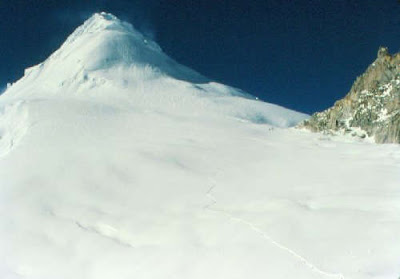
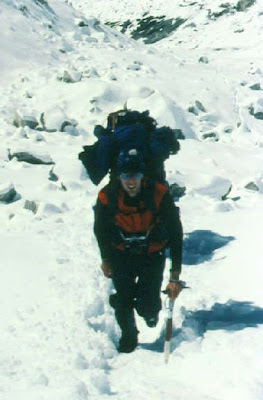
So, we asked our friends at Tramserku Lodge in Namche Bazar to fix us up. They referred us to a friend who came up with a "guide" who in turn recruited two porters, and helped us outfit the expedition. We rented a tent, stoves, axes, crampons, and ropes (which the crew would return after our crossing), bought supplies (mostly granola, noodles and packaged soup), and set off for Tashi Laptsa.
This isn't about our great adventure, so I'll spare you the blow-by-blow. Just a few details. Then I'll get to the point.

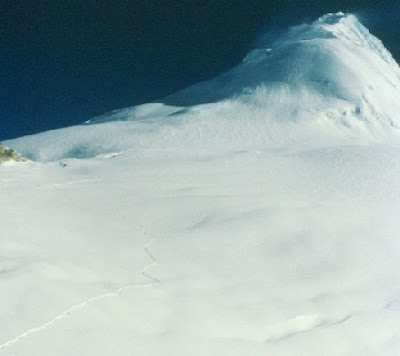
Tashi Laptsa is generally recognized to be one of the most formidable passes in the Himalayas. The pass is a saddleback on a north-south ridge that runs up to Pachermo (6145m; 20,300 ft), a so-called "trekking peak" that would qualify as a genuine mountain anywhere but the Himalayas. The approach from Thame (to the east) includes a steep climb -- not particularly technical under ideal circumstances... but we were setting out right after a one-meter snowfall. To the west, at the head of Rolwaling Valley, is a long stretch that is something of a shooting gallery: as soon as the morning sun warms the upper cliffs, there is a barrage of rockfall. Hard hats are de rigueuer, and if you get hit by anything larger than a pebble, the hat won't help. The winter sun is blinding, the temperatures are brutally cold after sunset (boots and socks would freeze solid if you didn't sleep with them in your bag), and in fresh snow, without the odd scraps of yak dung to guide you, the path is undetectable. In fact, there is no path per se -- the prevailing route shifts around from season to season.
Our first night out, the snow collapsed our tent and we had to return to Thame after spending the night in a squalid yak shelter. Our guys were great about setting up the tent and keeping it intact, even in the gale force winds of Noisy Knob, but after they helped set up the self-belay down to the glacier, they disappeared. We were very lucky to survive the trek across the rockfall and the maze-like glacial till to meet up with them well after dark on the lateral moraine above Tsho Rolpa. We made it to Na on the fifth day out of Thame -- exhausted, dehydrated, blistered, but in pretty good shape despite Thom's giardia (a vicious type of dysentery) and my own sunburn. I thought that since I was deeply tanned from weeks of trekking, I didn't need sunblock; the skin hanging in tatters from my nose and lips argued otherwise.
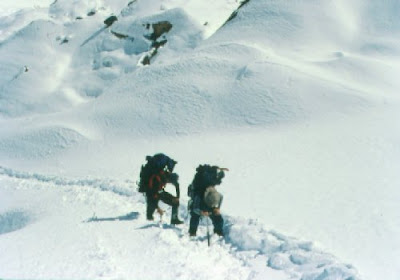

Despite the contretemps, we do not regret having organized our own expedition. But never mind all that. What lessons did we learn?
Let's start with what we did right. If you want to arrange a trek with guide and porters, it is generally to your advantage to do so as close as possible to the point where the support will actually be needed. If you book from abroad, you will generally be paying quite a bit more than if you show up at the trekking agency in Freak Street or Thamel.
You can save even more -- a lot more -- if you make arrangements exactly when and where you need help. Wherever you are going in Nepal, it is virtually always possible to pick up a porter for as many days as necessary; this will always be cheaper than paying Kathmandu prices. If, for instance, you want to do the Everest trail from Jiri to Kala Patar and then cross Tashi Laptsa pass to Rolwaling, you probably don't need any help at all for the first three or four weeks. Why pay for it?
Another advantage to waiting is that you may have a better idea of what you need once you are closer to your destination. Do you really need someone to meet you at the airport, hold your hand on sight-seeing tours, and keep an effective buffer between you and the ambient culture? Do you want to travel on a moving circus with 25 other tourists? Do you want some porter half your size to carry your load (and probably those of two other "membas") while you saunter along with a fanny pack and a water bottle? Do you want to stay in a tent and have your own chef cook for you, when you could be staying in a nice warm tea-house picking your meals a la carte? My bias, as I've said, is strongly in favor of independent backpacking, which means carrying as much of your stuff as possible, and only resorting to services when and where necessary.
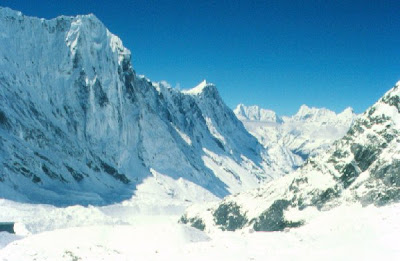
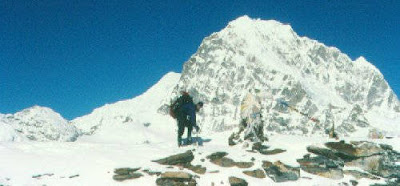
The main problem is equipment. You can get virtually anything you need or want in Kathmandu, Namche Bazar, or Pokhara. In many villages you may find toilet paper, biscuits, batteries, even canned goods, batteries, walking sticks, and ice-axes. Just don't count on buying necessary supplies for Tashi Laptsa once you are in Beding or Thame (the last villages before the pass). That doesn't mean you have to lug everything all the way from Kathmandu or hire a porter, though. You can arrange to have a load flown in to a lodge in Lukla (a day below Namche), or even have it portered to the lodge of your choosing in Namche Bazar, where it can be held until you need it. Most of the lodges in Namche are pretty well connected with both Lukla and Kathmandu. If you were to stay in the Tramserku View Lodge at Namche, for instance, they would be able to take care of all your needs, and, since they aren't in that business, they would probably only charge for room and board. The room charge, by the way, is strictly nominal as long as you're eating at least one meal a day at the lodge. You can also ask your lodge keeper to switch your flight out of Lukla, get you a refund, or book a departure on short notice: in such a tight community, everybody has a relative who works for an airline. Or owns it.
In Namche you can easily make arrangements on your own for a guide and porters. However, you will have a lot more to think about than if you let one of the big companies handle everything. And that's what this column is really about. Keep in mind that this is written from the perspective of spending as little as possible and yet having a reasonable chance to survive; if you prefer more comfort and safety, you need professional help -- from a tour operator. And perhaps from a therapist, as well.
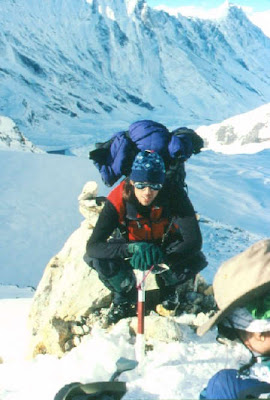
What do you really need to cross Tashi Laptsa?
First of all, you should consider what you DON'T need. You are going to pay a high price, in money or in pain, for extra kilos. Do you really want that Walkman or your 800-page beach novel? Do you need the whole guidebook, or will a few pages do? How many socks and underpants can you get by with? (Remember, you won't be showering for a LONG time!) Shampoo? Back-up camera? Hellooo?!?
Okay, you've got your regular pack together. A few extras, a few modifications:
- tent: a good one. Noisy Knob, one of the few mid-route spots suitable for pitching a tent, is exposed to gale-force winds. Check all the stakes, guidelines, and zippers.
- sleeping bag: whereas you could get away with a summer bag on the Everest trail since there are teahouses and even blankets, you will be sleeping in a tent, at below freezing temperatures, for at least a couple of nights.
- ground pad; space blankets; plastic sheeting (a couple of meters for each trekker); rain poncho
- cold-weather gear for the camp... probably not for actual hiking, unless you get lost and caught out after sunset. Bring: warm coat, fleece vest, synthetic (sweat-wicking) underwear and tee-shirts, double socks, zip-on overalls, gloves (and preferably also liners), very good technical boots (preferably double plastic boots like Koflach) capable of accommodating crampons; crampons
- ice axe (not just ski poles)
- hard-hat (helmet) to protect you from falling rocks
- climbing rope
- very good flashlight, extra batteries, extra bulbs
- stove, cooking gear, food for five days. Lots of snacks, especially chocolate bars and nuts. If you're bringing cans, don't forget the can-opener.
- water bottles: at least two liters per person
- medicine: your regular trekking kit should do. Make sure you have pain killers, anti-inflammatories (e.g. Ibuprofen), bandages, sleeping pill, and extreme sunblock.
Virtually all of this equipment, and much more, can be obtained in Namche. The exceptions might be large-size helmets, very large boots, and some medicine. There is no pharmacy in Namche, but a pretty good variety of basic medicine is available at the trekking shops and in recycle bins at lodges, or from the clinics. However, the clinics charge something like $10 for trekker consultations, and medicines are much more expensive than in Kathmandu. Pain-killers are especially hard to come by. So, stock up in Kathmandu; in a pinch, you could get basic medical supplies supplies in Dolakha, Lamosangu, or Charikot.

Screw-ups
One problem in arranging a Tashi Laptsa expedition from Namche is that you're not dealing with a reputable fixed-base agency. They won't have a brochure or a price-list to show you. And you'll probably be going one-way, so you won't be coming back to complain if something goes wrong. Almost all (if not all) of the trekking store owners are helpful and honest, but they're subcontracting to guides and porters whom they may not know very well.
Here are some specific things that can go wrong:
- You need one guide and porters to carry 75 kg of equipment. Your outfitter, probably a trekking shop owner or lodge proprietor, assures you that the whole thing can be arranged for $300. On talking it over with his prospective guide, he finds it's going to cost $750. You ask him to look for someone else, and the eventual price is $450.
- The guide wants payment in full, in advance. What leverage does that leave you?
- You are told that your equipment is too much for two porters, who must also carry their own gear. So the equipment is split three ways, with the "guide" carrying part of it. Later on, you find that the guide considers himself a porter by virtue of that extra load and wants to walk with the other two porters, leaving you trekkers to pick out the trail on your own.
- When you talked to him in Namche, your guide seemed to speak English okay. Out on the trail, it turns out he doesn't.
- Your staff tells you they'll meet you at the new campsite... 4 hours' easy walk ahead, they assure you. Five hours later you're halfway there, and need to stop soon. But they have all your camping equipment. Even if your guide is with you, what can you do?
- You are told the guides and porters will have all their own equipment. Later it turns out that they don't have a rope. They don't have a tent. They were planning to stay in caves... probably not your preferred accommodations. They don't have enough cooking utensils, and have to borrow your pot, bowls and spoons. Nor do they have enough food: you were willing to share some of your stuff anyway, but it seems they're pilfering additional supplies. (It is fairly typical for personnel on treks, whether large or small, to help themselves to trekkers' personal supplies.)
- One day out, it starts to snow. Now what?
- The outfitter said something about tipping the crew at the end of the trail... how much is up to you... more for the guide than the porters... So how much is appropriate? And really, they're nice guys, but they screwed up on you pretty royally. What do you do?
Precautions
This is by no means an exhaustive list. I'm assuming you've read one or two good guidebooks (e.g. Jamie MacGuinness' Trekking in the Everest Region), know all there is to know about altitude sickness, have at least a core vocabulary in one of the local languages, and have been trekking long enough to know your capabilities. These are just a few specific suggestions about organizing your team for Tashi Laptsa; you will have to judge to what extent they may apply to some other project.
- Leave yourself some slack. Don't expect to move out the day after you contact an outfitter (whether professional or ad hoc). If you're passing through Namche on the way to Everest Base Camp before crossing to Rolwaling, make arrangements for a crew before leaving Namche the first time.
- Write out your agreement. Don't consider the arrangements a done deal until both the outfitter and the guide have signed it.
- Have a conversation with your guide before accepting that he speaks English. Ask questions that require long answers -- for instance, "Tell me about your most recent crossing of Tashi Laptsa." Don't just ask a few questions that anyone could answer without really knowing English ("What village are you from?" "How many times have you crossed Tashi Laptsa?" "How many days does the crossing take?")
- Personally inspect the crew's gear a day before leaving. Pay attention to everything: boots, flashlight, sleeping bag, cooking gear, food.
- Discuss bad weather scenarios. How many days would it be reasonable to hunker down before calling it off? If you have to return, do you get any money back?
- Talk to a few locals in Namche about the tipping issue. Make sure you have on hand the exact change that you will need at the end of the trail.
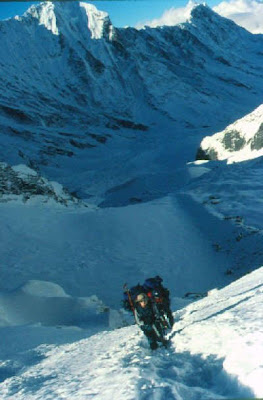
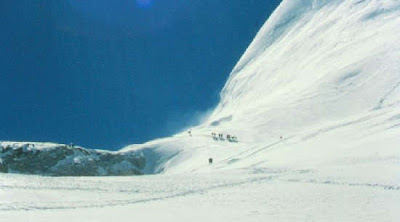
In most cases, the major reason to acquire a crew is that you need help carrying equipment. If you're going someplace dicey like Tashi Laptsa (where there are Sherpa fatalities nearly every year), you might want to make further contingency plans: before you leave home, purchase evacuation insurance (more useful for recovery than rescue); leave detailed itineraries with someone in a position to send help if you go missing; write a will.
If my somewhat dour perspective has put a damper on your enthusiasm for a do-it-yourself adventure, that's okay. In my next couple of columns, I'll be talking about what it takes to levitate from your couch and knock off a bucket-list peak. No, not Everest ... that's way too expensive for my taste. But how about Cho Oyo? Sixth highest peak in the world (8201 m; 26,906 ft), and reasonably accessible. First step: a warm-up climb of the popular trekking peak, Mt. Mera (6476m; 21,370 ft). No, I haven't done either, but I'll let Himalayan legend Dan Mazur sell us all on a project we never thought we'd get snookered into.
Seth Sicroff, Nepal Editor for Wandering Educators
Manager, Sunrise Pashmina
Photos courtesy and copyright Seth Sicroff
